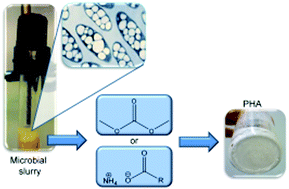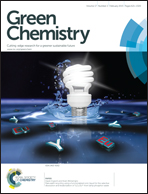Dimethyl carbonate and switchable anionic surfactants: two effective tools for the extraction of polyhydroxyalkanoates from microbial biomass†
Abstract
The availability of green and cheap technologies to recover polyhydroxyalkanoates (PHAs) from microbial biomass is crucial for the development of a reliable and sustainable production chain. Here, two novel protocols are proposed to extract PHAs from Cupriavidus necator. The first method is based on PHA-extraction with dimethyl carbonate (DMC), a green solvent that is completely biodegradable and less harmful to humans and the environment than most solvents. The procedure can be applied directly to concentrated microbial slurries or to dry biomass, affording very high polymer recovery (>85%) and excellent purity (>95%). No degradation/decomposition of the polymer is observed in both cases. The second protocol uses fatty acid carboxylates as surfactants, which disrupt cell membranes, providing excellent polymer recovery (>99%) and high purity (>90%). Ammonium laurate can be successfully used and easily recycled (98%) by lowering the pH through CO2 addition. Therefore, both protocols reported here are effective and sustainable: the recovery and purity of the obtained PHAs are very high, the use of toxic chemicals is avoided, and the recycling of various solvents/surfactants used in the processes is optimal.


 Please wait while we load your content...
Please wait while we load your content...